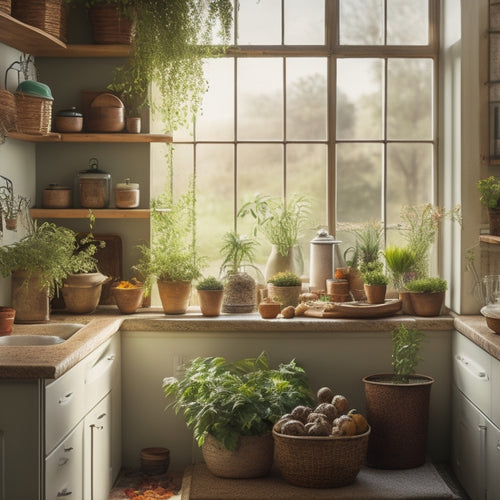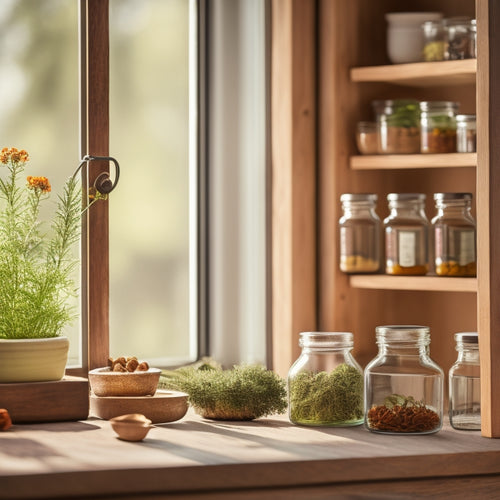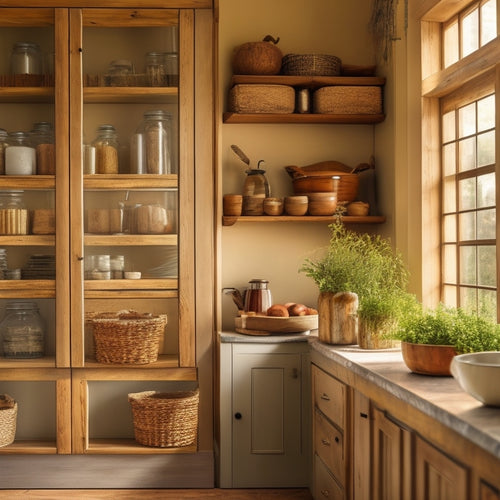
7 Best Accessible Kitchen Design Tips for Seniors
Share
You want to create a kitchen that's safe, functional, and enjoyable as you age. Start by designing wide walkways with clear navigation, eliminating tripping hazards and spacious work zones. Task-oriented lighting will help with clarity, while a single-level kitchen layout will make it easy to move around. Easy-to-use faucets and sinks, comfortable seating, and intuitive controls will also support your independence. Don't forget about clear visibility for safe cooking and maximizing corner cabinet space. By incorporating these accessible kitchen design tips, you'll be well on your way to a kitchen that adapts to your needs. Explore these principles further to uncover more innovative solutions tailored to your unique needs.
Key Takeaways
• Design a spacious layout with wide walkways, clear of tripping hazards, and ample space around work zones for easy navigation.
• Prioritize task-oriented lighting with a layered effect, task-specific illumination, and reduced shadows on work surfaces for clarity.
• Opt for a single-level kitchen layout with open shelving, eliminating barriers and obstacles, and prioritizing functionality and convenience.
• Choose user-friendly faucets and sinks with touchless or single-handle operation, shallow depth, and comfortable height for ease of use.
• Incorporate sit-down workspaces with ergonomic chairs, flexible countertops, and adjustable shelving for comfortable meal prep and storage.
Wide Walkways for Easy Navigation
To guarantee you can move safely and comfortably around your kitchen, plan for walkways that are at least 42 inches wide, allowing you to easily navigate around countertops, appliances, and other obstacles. This will give you the freedom to move around without feeling claustrophobic or worried about bumping into things.
With wide walkways, you'll be able to access your open shelves and corner spaces with ease, making it simpler to retrieve the items you need.
When designing your kitchen, consider the 'work zones' where you'll be preparing meals, cooking, and cleaning. Make sure these areas have ample space to move around, and that your walkways are clear of any tripping hazards.
Task-Oriented Lighting for Clarity
When designing your kitchen, you're likely thinking about how to create a space that's easy to navigate and use. Prioritizing task-oriented lighting that helps you see what you're doing, whether you're chopping veggies or reading recipes, is crucial.
Ambient Light Layers
You'll want to create a layered lighting effect in your senior-friendly kitchen by combining multiple light sources to achieve the best clarity and visibility. This will help your senior loved ones navigate the space with confidence.
Start by incorporating natural accents, such as skylights or large windows, to bring in soft, gentle light. This will set the tone for a warm and inviting atmosphere.
Next, add a soft glow from overhead lighting, like recessed or pendant lights, to provide overall illumination. This will help reduce harsh shadows and make it easier to see. Consider installing dimmers to adjust the lighting levels according to the time of day or task at hand.
By layering these light sources, you'll create a comfortable and functional space that supports independence and safety.
Task-Specific Illumination
By strategically placing task-oriented lighting in areas where specific activities occur, such as under cabinetry or above countertops, you can create pools of light that help seniors focus on the task at hand. This type of lighting is especially important for seniors, as it can help compensate for declining vision.
When selecting task-oriented lighting, consider the color temperature of the bulbs. Warm white light (2700K-3000K) is easier on the eyes and can promote relaxation, while cool white light (3500K-4100K) can enhance focus and productivity.
Additionally, incorporating light therapy into your design can have numerous benefits for seniors. Light therapy can help regulate circadian rhythms, which can be disrupted by age-related changes. By placing light therapy lamps in areas where seniors spend most of their time, you can help improve their mood, energy levels, and overall well-being.
Reducing Shadows
To minimize eye strain and confusion, strategically position task-oriented lighting to reduce shadows on work surfaces, ensuring that essential areas like countertops and sinks remain well-lit and easily visible. By doing so, you'll create a more comfortable and functional kitchen space for seniors.
When planning your lighting design, consider shadow mapping to identify areas where shadows tend to fall. This will help you pinpoint where to place light sources to maximize visibility.
For instance, placing under-cabinet lighting can help illuminate countertops and reduce shadows cast by overhead cabinets. Additionally, use light reflection to your advantage by positioning lights in a way that bounces light off surfaces, further reducing shadows.
Single-Level Kitchen for Accessibility
A single-level kitchen, where countertops, sinks, and cooktops are all within easy reach, can greatly reduce the physical strain and effort required to navigate the space, making meal preparation a more enjoyable experience for seniors.
By eliminating barriers and obstacles, you can create a more accessible kitchen that allows seniors to move around comfortably.
Consider incorporating open shelving, which allows for easy access to dishes, cookware, and utensils without having to strain or stretch. This universal design principle prioritizes functionality and convenience, making it an ideal choice for seniors.
Furthermore, a single-level kitchen eliminates the need for stairs or stepping, reducing the risk of falls and injuries.
As you design the kitchen, think about the workflow and how you can create a seamless, efficient space that allows seniors to move freely and safely.
Easy-to-Use Faucet and Sink
You'll want to choose a faucet that's effortless to operate, even with arthritic hands or limited dexterity, as it's essential for independence in the kitchen. Look for faucets with advanced technology, such as touchless or single-handle operation, which can make it easier to turn on and off. Additionally, contemplate faucets with lever handles or paddle handles, which can be operated with minimal effort.
When it comes to sink materials, you'll want to opt for ones that are easy to clean and maintain. Here are some options to ponder:
| Sink Material | Benefits |
|---|---|
| Stainless Steel | Resistant to scratches and corrosion, easy to clean |
| Granite Composite | Durable, resistant to heat and scratches |
| Copper | Antimicrobial properties, easy to clean |
Furthermore, reflect on a sink with a single basin and a shallow depth to make it easier to access and clean. A wall-mounted sink can also be a great option, as it allows for more floor space and can be installed at a comfortable height. By selecting the right faucet and sink, you can create a kitchen that's both functional and accessible for seniors.
Comfortable Seating and Storage
As you design your accessible kitchen, don't underestimate the importance of comfortable seating and storage.
You'll appreciate having a sit-down workspace where you can take a break from standing, and storing frequently used items within easy reach will save you energy and effort.
Sit-Down Workspaces Matter
Sit-Down Workspaces Matter
Sit comfortably while preparing meals with a sit-down workspace that combines a sturdy chair and clever storage, allowing you to focus on cooking without straining your back or joints. As you age, mobility and flexibility can become a challenge, making sit-down workspaces a must-have in senior-friendly kitchens. With a dedicated area for food preparation, you can take breaks whenever needed and maintain your independence in the kitchen.
When designing your sit-down workspace, consider the following features:
| Feature | Description | Benefits |
|---|---|---|
| Ergonomic Chairs | Chairs with lumbar support and adjustable height | Reduces strain on back and joints |
| Flexible Countertops | Counters with adjustable height or removable sections | Accommodates different mobility needs |
| Storage Bins | Bins with easy-to-grasp handles and clear labels | Reduces bending and straining |
| Task Lighting | Adjustable lighting focused on the workspace | Improves visibility and reduces eye strain |
Storage Within Reach
Comfortable seating and storage converge in a senior-friendly kitchen where essential items are positioned within easy reach, allowing you to focus on cooking without exerting unnecessary energy. This thoughtful design approach guarantees that you can access what you need without straining or stretching.
Adjustable shelving is a game-changer in senior kitchens, enabling you to customize storage to your comfort level. No more climbing stools or bending down to reach heavy pots and pans! By installing shelves that can be easily raised or lowered, you'll be able to store and retrieve items with ease.
Corner optimization is another clever strategy for maximizing storage within reach. Consider installing carousel units or lazy susans in corner cabinets to make the most of this often-wasted space. This way, you can effortlessly access items like spices, oils, or cookbooks without having to navigate tight corners or awkward angles.
Simple and Intuitive Controls
You'll want to choose faucets, appliances, and lighting controls that are easy to operate, even with arthritic hands or declining dexterity. Simple and intuitive controls can make a significant difference in your senior's independence and confidence in the kitchen. Consider incorporating touchless technology, such as faucets that turn on and off with a wave of the hand or automatic soap dispensers. Voice-activated appliances, like smart refrigerators and ovens, can also simplify cooking tasks. These innovative solutions can reduce strain on joints and fingers, making meal prep more manageable.
When selecting appliances, look for ones with large, clear buttons and displays. Avoid complex interfaces that require multiple steps or intricate sequences. Instead, opt for appliances with straightforward, one-touch operations. Additionally, consider installing smart lighting systems that can be controlled with a single button or voice command.
Clear Visibility for Safe Cooking
Proper lighting greatly enhances clear visibility, allowing seniors to safely navigate the kitchen and accurately prepare meals without straining their eyes. As you design an accessible kitchen, consider the type and placement of lighting fixtures.
Installing under-cabinet lighting, for instance, can reduce harsh shadows and make it easier to read recipes or see ingredients. Additionally, using contrast colors for countertops, cabinets, and floors can help seniors distinguish between different surfaces and objects. This visual cue can be especially helpful for those with visual impairments.
When it comes to appliance placement, consider the 'work triangle' concept, where the sink, stove, and refrigerator form the points of a triangle. This layout allows seniors to easily move between tasks without having to walk long distances or navigate around obstacles.
Frequently Asked Questions
Can I Make My Kitchen More Accessible Without a Full Renovation?
You can definitely make your kitchen more accessible without a full renovation! Consider retrofit solutions and space optimization techniques to create a more functional and comfortable space that suits your needs.
Are There Any Specific Kitchen Design Certifications for Seniors?
You'll want to look for designers with Aging in Place (AIP) or Certified Aging-in-Place Specialist (CAPS) certifications, ensuring they possess Aging Expertise and adhere to Universal Standards, guaranteeing a safe and functional kitchen for seniors.
How Can I Ensure My Kitchen Design Is Adaptable for Future Needs?
You're planning for today, but thinking about tomorrow - that's smart! Incorporate Universal Design principles to create an Age-Friendly space that adapts to your needs, ensuring your kitchen remains functional and comfortable for years to come.
What Are the Most Important Accessible Kitchen Features for Fall Prevention?
As you design your kitchen, prioritize fall prevention by incorporating non-slip flooring and wide walkways, ensuring you can move safely and confidently, and making it easier to age in place with independence and dignity.
Can I Incorporate Smart Home Technology to Aid Senior Accessibility?
You've heard that smart home tech can revolutionize senior living, and it's true! You can incorporate voice assistants to control appliances and automated lighting to enhance safety and independence, making daily tasks a whole lot easier.
Related Posts
-

Tiered Kitchen Rack Ideas for Small Spaces
Tiered kitchen racks are perfect for maximizing small spaces while adding style and functionality. Install wall-mount...
-

Spice Rack With Integrated Herb Garden
A spice rack with an integrated herb garden alters your kitchen into a culinary haven. You'll have fresh herbs at you...
-

Freestanding Pantry Units for Farmhouse Kitchen Style
Freestanding pantry units perfectly blend beauty and function in your farmhouse kitchen. They maximize storage while ...


